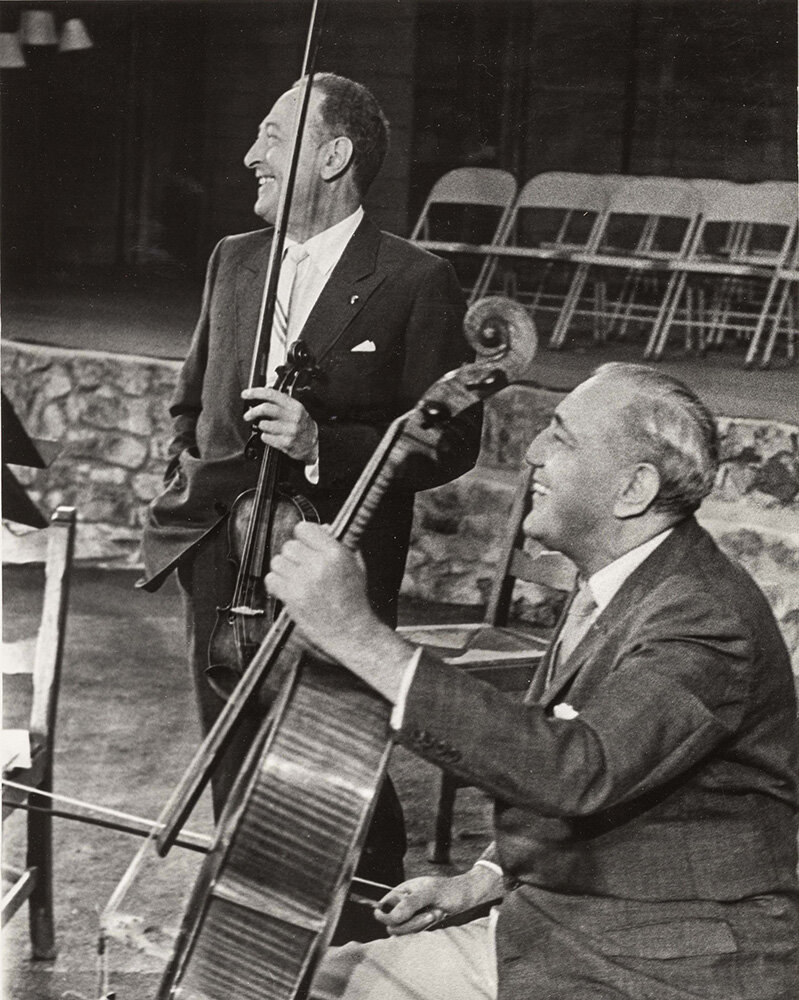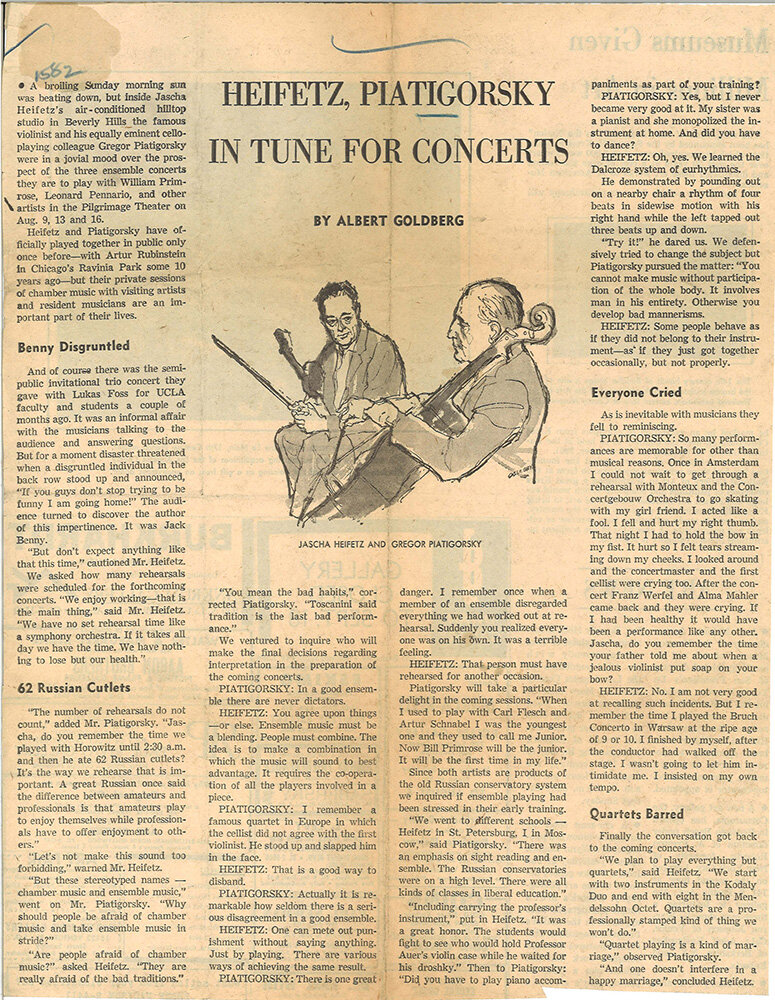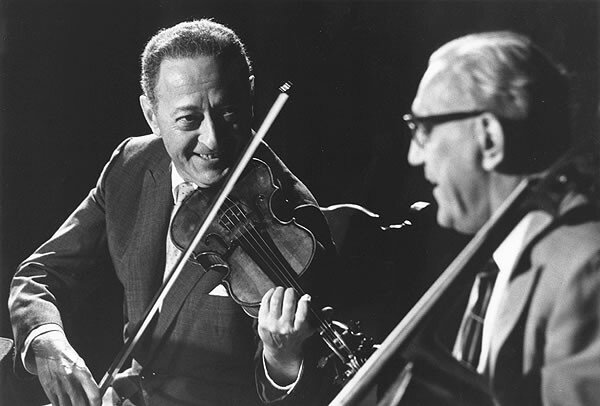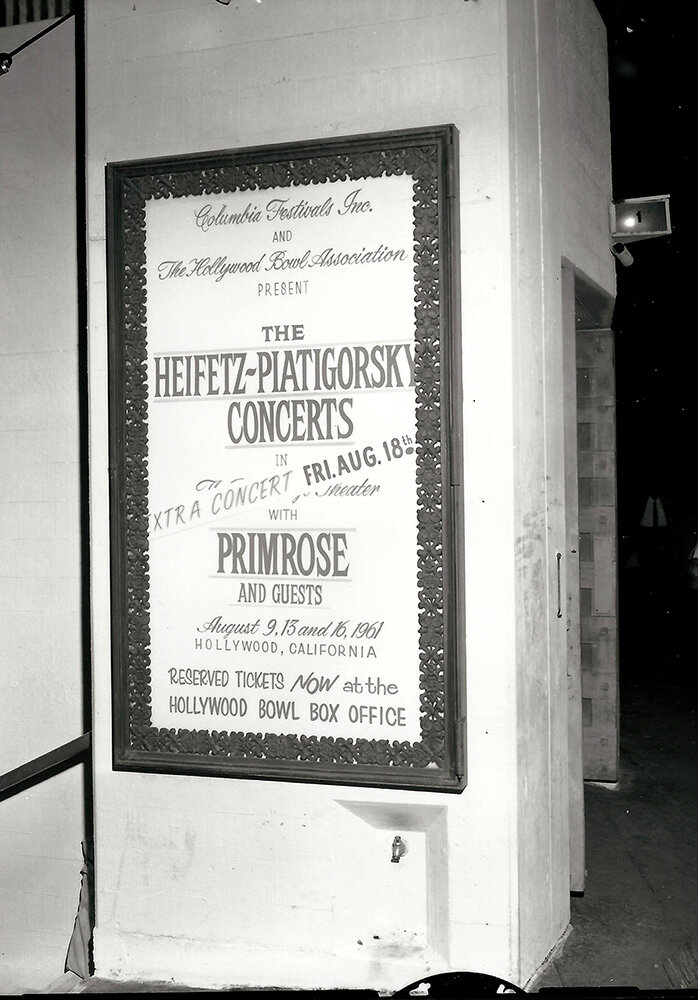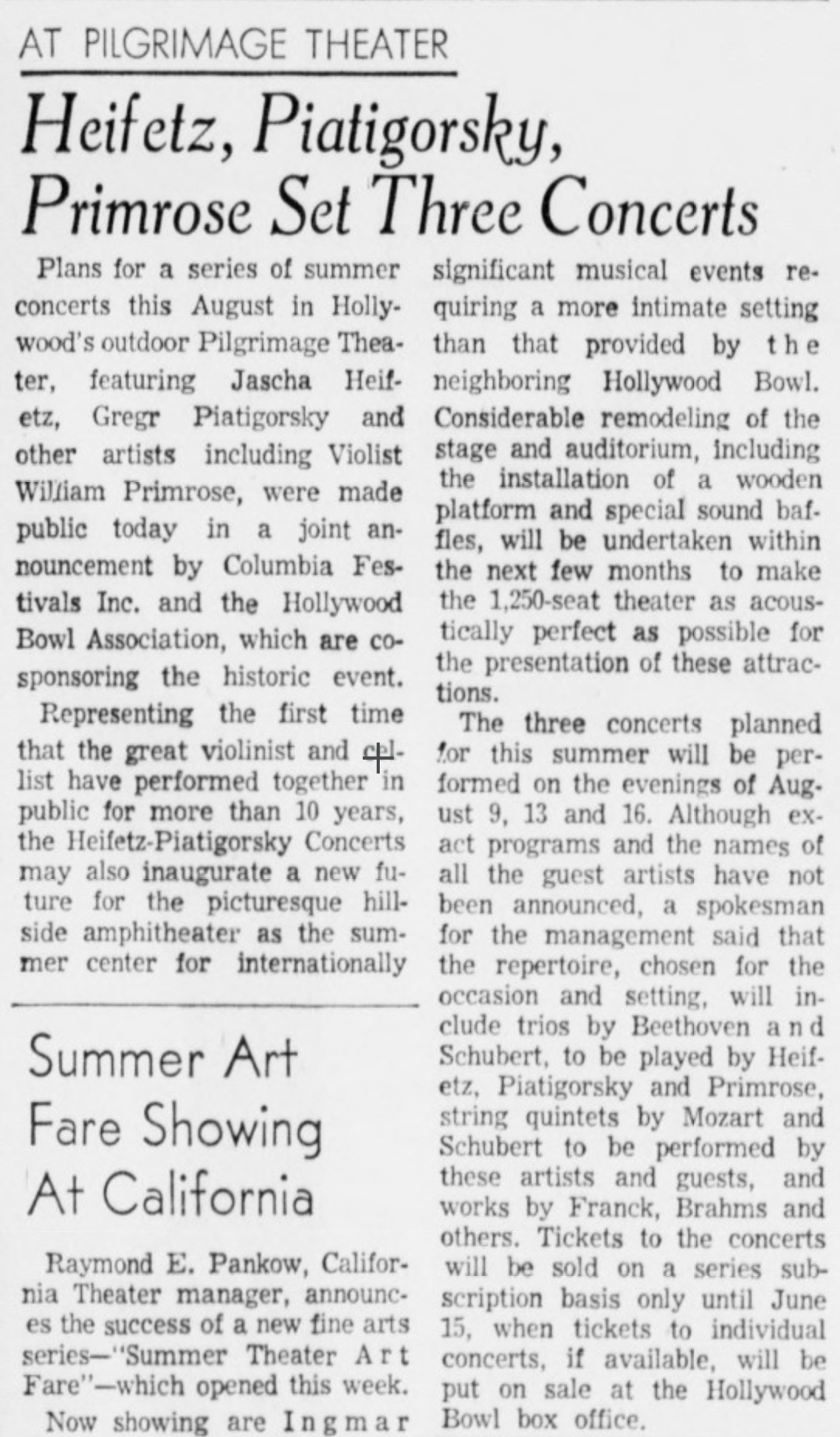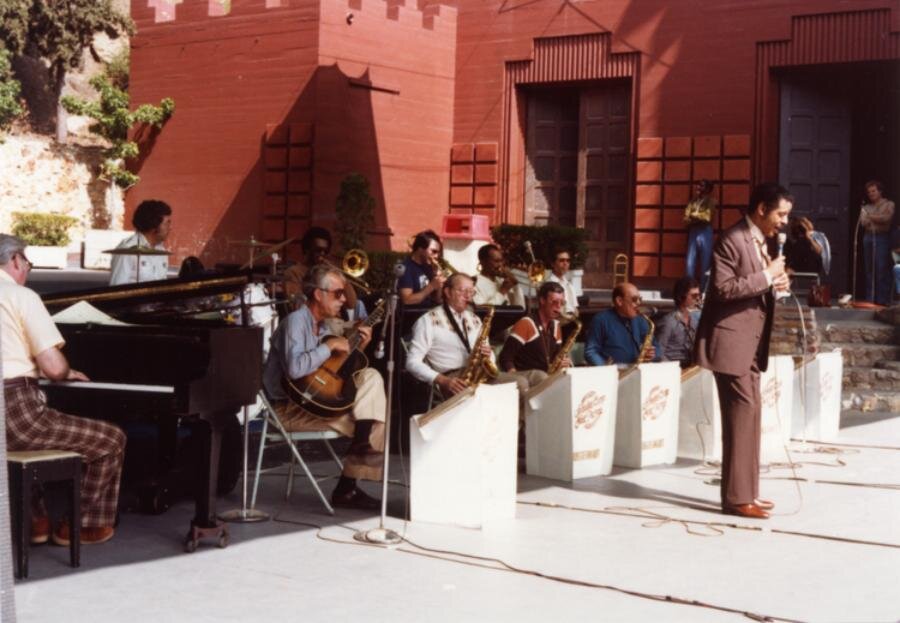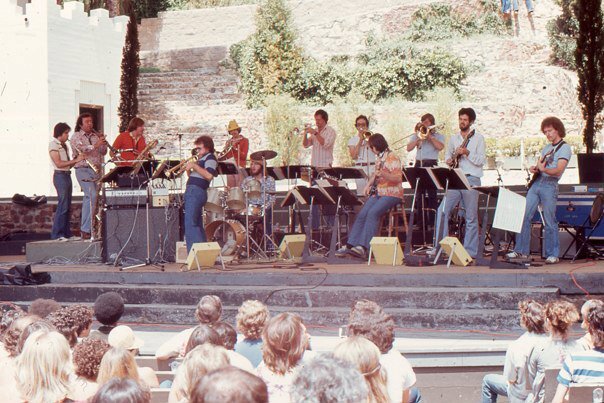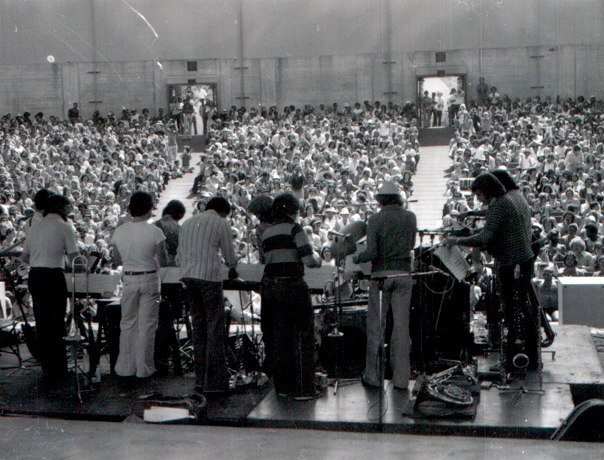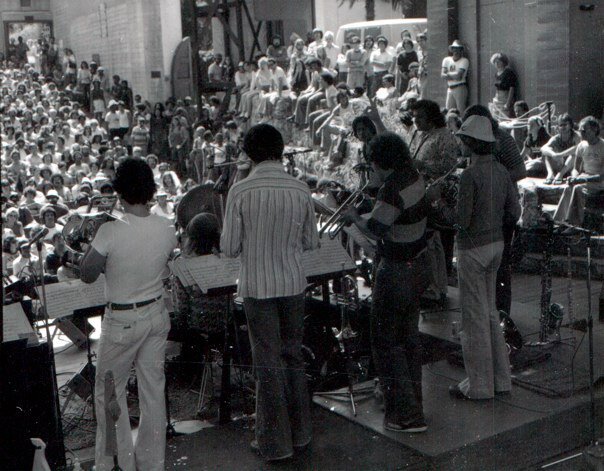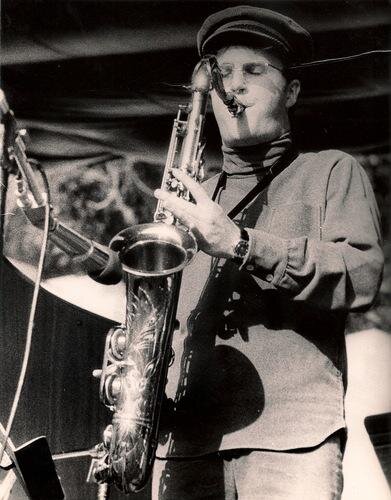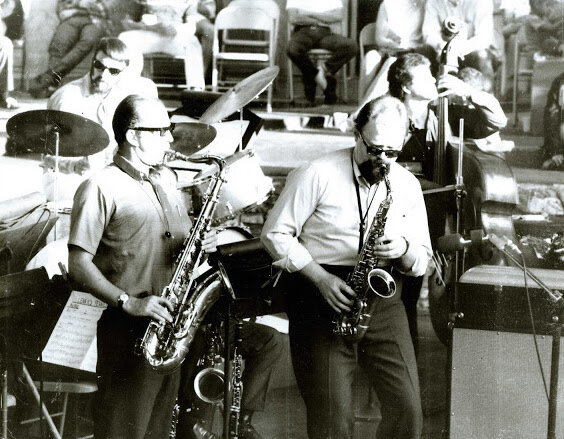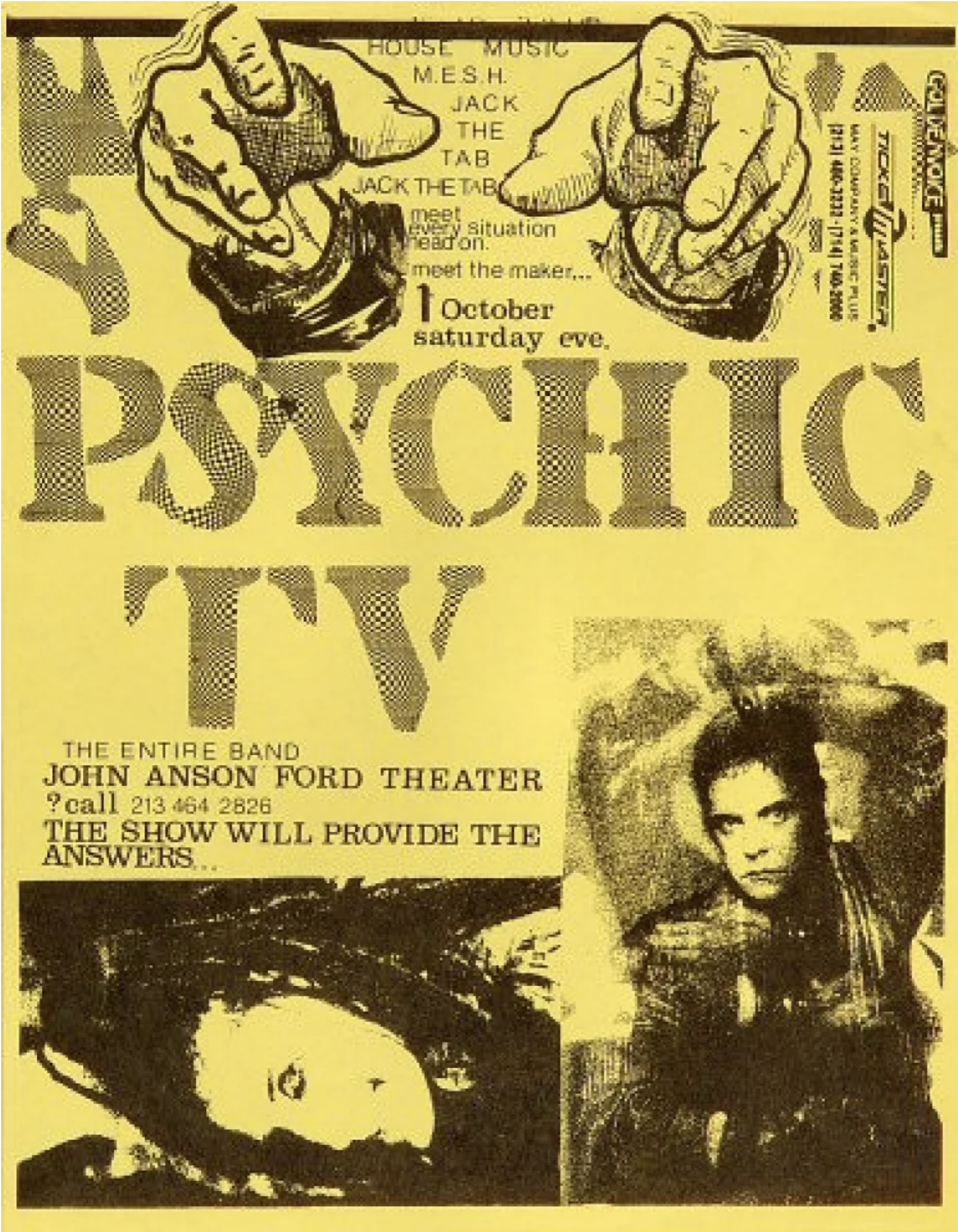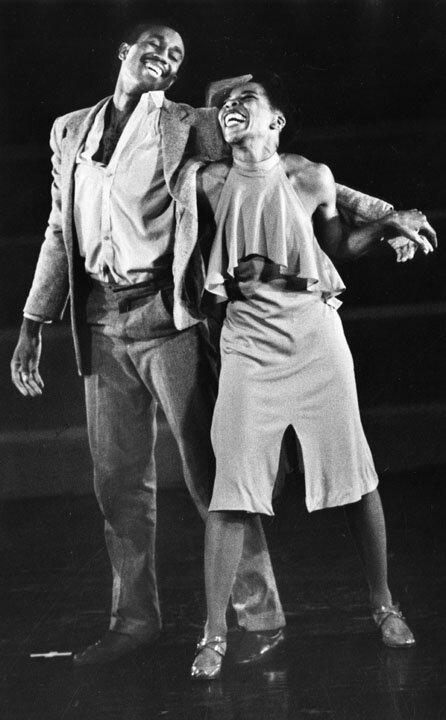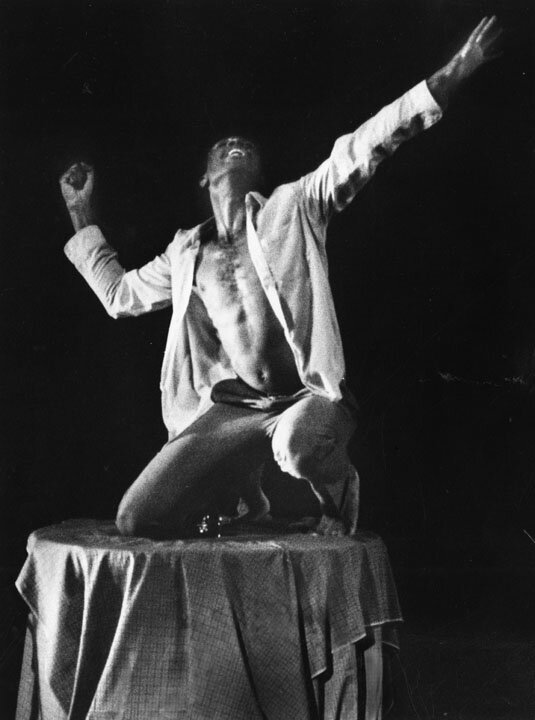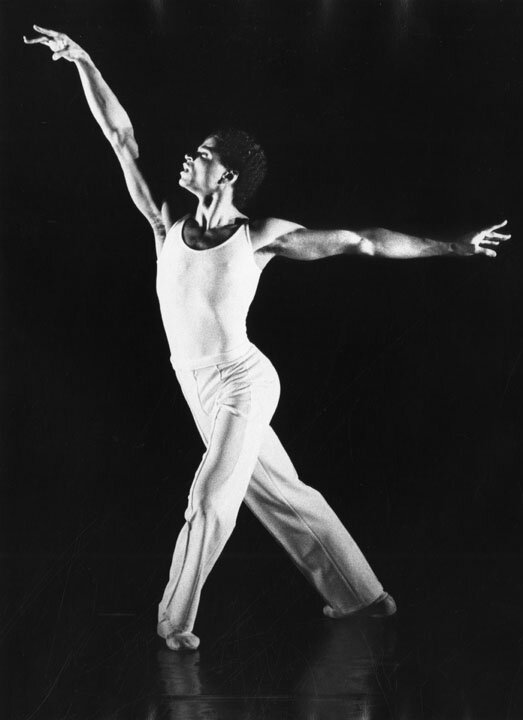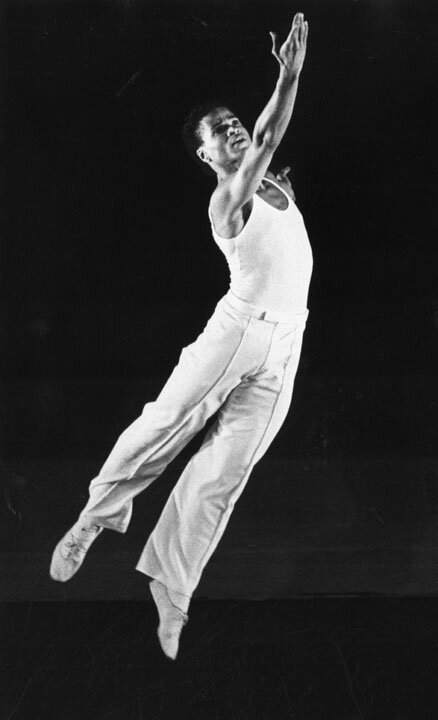
A Home for Intimate and Pivotal Performances Across Music Genres
1961: Heifetz-Piatigorsky Concerts Breathe New Life Into the Theatre
As the annual Pilgrimage Play wound down after 32 seasons, the first major classical concert on the Pilgrimage stage was the Heifetz-Piatigorsky duo. This concert represented the first time that the great violinist and cellist had performed together in public for more than 10 years and inaugurated “a new future for the picturesque hillside amphitheatre as the summer center for internationally significant music events requiring a more intimate setting than that provided by the neighboring Hollywood Bowl.” Both musicians lived in Los Angeles at the time and had known each other from the 1920s. They referred to each other as General Heifetz and Admiral Piatigorsky. Piatigorsky was Heifetz’s best friend; after he died, Heifetz was never the same.
1966-1985: Pilgrimage Jazz Series Echoes Throughout the Hollywood Hills
Throughout the tumultuous 1960s, ‘70s, and ‘80s, the Pilgrimage Theatre hosted a free jazz series every summer. Notable artists appearing on stage included Chet Baker in 1966, the Joe Pass Quintet in 1974, Willie Bobo in 1975 and 1977, local supergroup Turbulence in 1977 and 1978, and American jazz trumpeter Gerald Wilson played at least five different times over the course of three decades. The world’s events would intrude into the theatre as well: in 1968, Wilson’s performance was moved to the Hollywood Bowl after Martin Luther King was assassinated and interest in the performance skyrocketed. Just a few months later, Robert F. Kennedy’s assassination would postpone the performance of jazz pianist Stan Kenton.
1972: LA Philharmonic Plays for the First time on the Pilgrimage Stage
Though the LA Philharmonic was founded in 1919 and began performing its summer season in 1922 just across the freeway from the Pilgrimage at the Hollywood Bowl, it would take 50 years for the LA Philharmonic to actually play on the Pilgrimage stage. In 1972, an 8-hour exploration of 20th century music featured LA Phil musicians alongside dancers and actors in Day of New Music with Gerhard Samuel. Nearly 50 years later, LA Phil would take over as stewards of the Ford Theatres venue.
1988-1989: Two Summers of Punk Rock
In 1981, concert promotion company Goldenvoice Productions was founded. Named for a strain of marijuana, the promoter was soon subsidizing all of his concert bookings around Los Angeles with illicit sales of the same substance. Unaware of how the business was being run at the time was LA County Department of Parks and Recreation, which signed a ten-year lease of the Ford in 1986 with Goldenvoice to bring big name bands to the intimate outdoor stage. What began with folk rock acts soon turned to the 1980s’ most rowdy punk acts.
1988 shows included Henry Rollins (May 7), Social Distortion (May 28), Butthole Surfers (June 10), X and Redd Kross (June 28), Meat Puppets (August 26), the Ramones (July 16), and the Red Hot Chili Peppers (October 8). 1989 shows included an April 1 show with opener No Doubt before their debut album was released, a sold-out seven-night stand by Jane’s Addiction with Special Guests (April 20-29), Mods Mayday 10th anniversary event with eight bands and a motorcycle show (May 6), and Redd Kross with Christmas and Dinosaur Jr. (May 13).
Perry Farrell of Jane’s Addiction in April 1989. Photo: Lucy Snowe.
Photo: janesaddiction.org.
The Ramones were scheduled to play another 3-day run beginning on June 1, but on May 27, 1989, Wall of Voodoo with Mary’s Danish and New Marines would be the final rock show at the Ford when the ten-year lease held by Goldenvoice to bring acts to the Ford was cancelled by mutual agreement with the Department of Parks and Recreation. It had been a year of noise complaints, first by Hollywood Bowl patrons after the July ‘88 Ramones concert, and later from residents in the surrounding neighborhoods who said concert-goers were climbing through their yards to reach the hillside theatre. Goldenvoice would go on to found Coachella in 1999, and began bringing artists back to the Ford in 2000 with Modest Mouse and more than 40 other musicians over the next twenty years.
1989: Chamber Music Under the Stars Series Becomes Compliment to the Hollywood Bowl Series
Compared to the Chamber Music Under the Stars program across the street at the Hollywood Bowl, Ford’s series would offer audiences a much more intimate exposure to the music. Beginning in 1989 and continuing intermittently for at least twenty years, Ford’s Chamber Music Under the Stars brought to the stage the Emerson String Quartet, Weiss Duo, Bronfman-Lin-Harrell Trio, Takacs String Quartet, Kalichestein-Laredo-Robinson Trio, Mischa & Cipa Dichter, Salsa LA Festival, Colorado Quartet, the Muir String Quartet, and many more. Seen here in rehearsal, LA County Supervisor Ed Edelman was instrumental throughout this period in bringing jazz and chamber music to the Ford stage (and at times even playing on it himself).
“Imaginative programming is seldom the hallmark of summer concerts, particularly outdoors. It has been at the John Anson Ford Amphitheatre, however, where the Weiss Duo Monday gave the third and final concert of the Los Angeles Philharmonic-sponsored chamber music series.”
Every Decade Brings Top Names in Folk and Rock to the Ford Stage
Countless big names in folk and rock ‘n’ roll history would play from the intimate stage over the decades. In 1969, The Byrds played a benefit concert at the Pilgrimage to raise funds to rebuild the infamous LA music club Ash Grove, which had recently been destroyed by a fire. 1971 brought Iggy Pop alongside Red Eye, Solomon Burke, and the Muscle Shoals Band. On April 20, 1974, Jerry Garcia played on stage with the eclectic supergroup Great American String Band for the very first time.
In 1988, concert promoter Goldenvoice established a relationship with the Ford and one of the first artists they brought to the stage was a double bill of John Prine and Nancy Griffith. Goldenvoice would also usher in the “punk era” at the Ford, quickly leading loud music to get banned from the Ford stage after complaints from patrons at the Hollywood Bowl. But just a few years later, 21 year old Alanis Morissette, on the brink of her stardom, brought Jagged Little Pill to the Ford stage. LA Times pop music critic Robert Hilburn described Morissette’s 1995 sold-out shows at the Ford as “spectacular” and pronounced that: “Morissette is an artist whose time has surely come.” Tornado records made a live recording of the show and released the album later that year as Rockin’ the Ford.
The following year, Counting Crows would record 17 tracks at the Ford, with several of them making their way onto the Daylight Fading live album series. In 1997, Toad the Wet Sprocket brought their Listener Appreciation Tour to the Ford. That same year, Beck played a 9:00 am breakfast show at the Ford, broadcast by KROQ, later released as live album Devil’s Tooth. In 1999, Natalie Merchant ventured on her first solo tour, stopping by the Ford in October. 2001 brought the icelandic group Sigur Ros out for only their second US performance.
For the next two decades everyone from Blues Traveler to Norah Jones to Wilco to Blur have appeared at the Ford. Rufus Wainwright would be one of the latest rock musicians on stage at the Ford, performing August 20, 2019, and later releasing recordings of the performance on the album Northern Stars.
“Brilliant,” Sigur Ros frontman Jonsi Birgisson kept repeating as he stepped onto the stage at the L.A.’s John Anson Ford Amphitheater for a late afternoon sound check. Smiling and shoeless, he padded around in his mismatched socks and baggy cargo pants looking up at the blue sky. The outdoor theater in the Hollywood Hills was one of those “special places,” he said, like the churches they prefer to perform in, where audiences “actually want to sit down and listen to the music.”
A Home for Modern and Multicultural Dance
1959: ANTA West Launches a Decade of Dance Theatre Festivals
The American National Theatre and Academy was established in 1935 to be the official alternative to for-profit Broadway productions, a quasi-precursor to the League of Resident Theatres. By the 1960s, there were many local branches across the country, including ANTA West based in Los Angeles, founded in 1957. Their mandate was to stimulate public interest in the performing arts and to foster and support theatrical activities in the area. By 1959, ANTA West launched the Dance Theatre Festival at the Pilgrimage Theatre and continued producing the festival each year through 1971. The 1969 festival included performances by Negro Classic Ballet Company, European Folk Ballet, Dance Center West, Mother Goose storytellers, Hollywood Shakespeare Festival Co, and San Gabriel Valley Ballet.
“As both co-producer and presenter of concert dance, the Ford Theatres has played an important role…a seminal role, even, in the success of many local dance companies. The Ford commits to artists over long periods of time and helps them grow…this is rare in Los Angeles.”
1972: Pilgrimage Theatre Welcomes National Dance Company of Mexico
Many dance companies graced the stages of the Pilgrimage Theatre throughout the century. In 1972, the National Dance Company of Mexico brought a magnificently costumed ballet of 50 dancers called Fiesta Folklorico to the Pilgrimage stage for a 10-day residency, as part of their US-wide tour. Director-choreographer Sylvia Lozano packed over 500 years of Mexican history into her two-hour-long show, featuring some of Mexico’s finest dancers, alongside mariachi, marimba, and Jarocho bands.
1976-1985: Dance Kaleidoscope Series Showcases New Artists
The Los Angeles Dance Alliance was founded in 1976 as a nonprofit service organization for choreographers and dancers. That same year, the Alliance founded the Dance Kaleidoscope festival to showcase local dance companies on the newly renamed Ford Theatre main stage. During the festival, each company typically had only one-half hour of tech rehearsal and one performance on stage. Companies and choreographers such as the Negro Classic Ballet Company, Valley Concert Dance Theatre, Marty Loughrie, and Wong and Teruel had breakout performances over the years. The annual festival lasted through 1985 in this original incarnation, before going dormant when LA Dance Alliance disbanded. The series would eventually be revived in 1989 at Cal State University and made its way back to the Ford stages from 1993-2002
“As a child in the audience, a dancer, choreographer, and arts administrator, I can see the arc of my career reflected in the Ford Theatres. I remember watching my mom dance there in the 1970s, and even as a kid I knew it was important. It has become like a home – I always felt special performing in that space.”
1985: Ambitious Black Dance Retrospective Celebrates Established Artists
In 1985, the Board of Directors of the Los Angeles Area Dance Alliance decided to produce an ambitious dance festival at the Ford over the course of four weekends in July featuring more established artists than those presenting in that (final) year’s Dance Kaleidoscope. On July 14, the Festival curated a Black Dance Retrospective featuring the Ruby Millsap Dance Theatre, Diamano Coura West African Dance Company, Chester Whitmore and Company, and solo dancers Ronald Brown and Lettie Battle.
“Both Whitmore’s “Retrospective” and the pieces by Diamano Coura featured live accompaniment—and what a difference that made from jukebox playbacks elsewhere. Indeed, the West African-style drumming sustained a level of excitement that Lee and the other Diamano Coura women rode to something like glory. Unified by the strong rhythmic pulse, Zak Diouf’s “Klake” (from Liberia), “Ekon-Kon” (from Senegal) and “Marakadon” (from Mali) incorporated in cohesive line dances both flashy solo displays and bits of character pantomime. At one point, with every engulfing, galvanic lunge, the dancers blew a wave of kisses forward—kisses from the vortex of a small on-stage tornado. The audience, understandably, went bananas.”
1986: Pilobolus Premieres ‘Was Black’ in Response to That Year’s Chernobyl Disaster
Photo by Javier Mendoza
What’s on the Ford’s stage has long been a reflection of and reaction to what’s happening in the world. One spectacular case of this occurred in 1986, as part of the multidisciplinary Visions at the Ford: Film, Dance and Performance festival. There, two-months to the day of a horrific nuclear disaster, Pilobolus dance company premiered, Was Black. The performance’s title was based on the loose translation of the Russian for Chernobyl where “Cherno” means “black” and “byl” means “was.” Rachel Rosenthal’s 17-minute performance featured songs in Russian and must have been a moving experience for all who attended.
A Home for Shakespeare and Children’s Theatre
1963 - 1971: ANTA West Produces Children’s Theatre Carnivals to Entice More Families to the Pilgrimage Theatre
The first programming at the Pilgrimage explicitly intended for children and families began in 1963 with the Children’s Theatre Carnival, a two-day affair co-sponsored by the Los Angeles chapter of the American National Theatre and Academy and the LA County Parks and Recreation department. At the time, ANTA West was also running an innovative-for-the-time program, which provided tickets and bus service to students to introduce them to the theatre, though it’s unknown whether they brought students to the Pilgrimage Theatre, perhaps to the Children’s Chamber Music concert in 1968. The Children’s Theatre Carnival at the Pilgrimage continued annually through 1965 and then came back in 1970-71, after which ANTA stopped supporting the Festival. It’s likely that the next twenty years at the Pilgrimage/Ford focused on adult audiences, but we know that in 1990 California Youth Theatre performed two plays in repertory on the Ford stage: Cyrano de Bergerac and Annie Get Your Gun. Throughout the ‘90s, performances for young people would become increasingly prevalent on the Ford main stage, including Lula Washington Dance Theatre, LA Mozart Orchestra, LA Children’s Chorus and the Kaleidoscope for Kids series. From 1994’s Children’s Concert Series onward through 2019’s JAM Sessions, families have found the Ford offering fun times for kids of all ages, every year.
1964’s King Lear to 2005’s East LA Classic Theatre: A Run of Shakespeare Residencies
Rumor has it that in 1912, John Barrymore, famed stage actor (and great-great-grandfather to Drew Barrymore) was frolicking in the Cahuenga Pass reciting soliloquies from Hamlet when he declared, “What wonderful acoustics – there should be a theatre here!” Less than a decade later, Christine Wetherill Stevenson would raise the funds to build the Pilgrimage Play Theatre on that very spot. But it would take until 1964’s production of King Lear for the Bard’s words to be spoken on stage at the Pilgrimage in front of an audience.
New Shakespeare Company of San Francisco began their national tour in 1970 by first stopping by the Pilgrimage to perform A Midsummer Night’s Dream and As You Like it. A newspaper review of the time noted, “The most striking achievement of the group is changing Shakespearen drama from stiff, formal, cultural-but-boring fare to vibrant, alive, culturally relevant theatre. The stage bounds with life as the multi-racial, multi-age cast sings, shouts, and dances their way through the play.” The productions were directed by company founder Margrit Roma, formerly a member of Bertolt Brecht’s theatre company and friend to Max Reinhardt. The New Shakespeare Company of San Francisco would eventually become the San Francisco Shakespeare Company, still around today.
The Los Angeles Free Shakespeare Festival brought John Ritter, Roscoe Lee Browne, Joan Van Ark, and David Hasselhoff to the Pilgrimage stage in 1973’s production of As You Like It for their inaugural season, with the support of the LA County Parks and Recreation Department and the American National Theatre and Academy. Producer Michael Dewell noted at the time, “Greater Los Angeles - in which one out of every twenty-five Americans lives - boasts one of the world’s finest outdoor legitimate theatres. The Pilgrimage has been made available to the Festival for $1 per year for our ‘fully professional but totally democratic theatre,’ available to the public without charge. In addition, the Parks and Rec is providing office space, maintenance, and support services which altogether represent a major commitment by local government to Free Shakespeare.” The LA Free Shakes Fest maintained a home at the Pilgrimage through 1979 including featuring noted TV actor Raymond St. Jacques as Othello in 1976. In 1980, LA Shakespeare Festival became the Free Public Theatre Festival, moving to the more intimate Gallery Theatre in Barnsdall Park and initiating contemporary plays.
Shakespeare Festival/LA would take up the mantle for Shakespeare at the Ford in 1988 with The Comedy of Errors and continue with several weeks of new performances each summer through 1993. The company was notable for offering program notes in Spanish and Japanese, a rare endeavor in the 1980s. Their 1989 production of As You Like It brought to the Ford stage actress Rita Wilson, who had recently married actor Tom Hanks. The company is still in existence, now operating as The Shakespeare Center of Los Angeles.
East LA Classic Theatre would be the last major Shakespeare company to maintain a consistent relationship with the Ford during this period, bringing a new performance here each year from 1997-2005. The company was founded in 1995 to be the nation’s only Latino-based theatre company that offers professionally performed Shakespeare adapted for youth in underserved communities of color. Their 1998 production of Twelfth Night on the Ford stage “has been transplanted to the glitzy realm of today’s show-bizzy L.A. in order to make it more accessible. I saw in people like Orsino, Olivia and Malvolio archetypes of some of the people we see every day in Hollywood and in the music business,” founder Tony Plana noted. “So we’ve set it in a pop music world and turned Orsino and Olivia into pop stars.” East LA Classic Theatre would continue engaging Los Angeles youth through 2018.
1998: East LA Classic Theatre Twelfth Night

